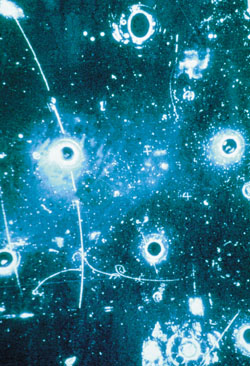In the summer of 1973, an experiment at the Gargamelle bubble chamber at CERN discovered a new physics effect. Gordon Fraser looks back at how confirmation of the existence of neutral currents ushered in a new understanding of physics.
A quarter of a century ago, after raging controversy and nailbiting doubt, an experiment at CERN discovered “neutral currents” in neutrino interactions. For the first time, the weak force had been seen to act without shuffling electric charges
The saga has been covered many times, notably by Don Perkins of the Gargamelle collaboration speaking at the 1992 “Rise of the Standard Model” historical seminar held at the Stanford Linear Accelerator Center (SLAC). Five years ago, for the 20th anniversary of the discovery, several CERN Courier articles recalled those momentous times, when two complementary experiments Gargamelle at CERN and the E1A electronic experiment at Fermilab had to resolve difficult problems chasing a will-o’-the-wisp physics effect, while in the wings many physicists steadfastly refused to believe in neutral currents.

In 1973 CERN had yet to reach full scientific maturity. European physicists were not used to making major discoveries at their accelerators and were sometimes hesitant to swim against powerful currents of opinion. The discovery enabled CERN to attain research maturity.
It was not the first time in modern physics history that dogma had to be revised virtually overnight. For a quarter of a century, physicists had believed that quantum mechanisms are unaffected by space reflection (parity) and particleantiparticle charge conjugation. The dramatic overthrow of these principles in 195657, following a bold hypothesis by T D Lee and C N Yang, underlined how much weak interaction physics could be ignored by so many for so long.
The weak interaction scene had been set in the early 1930s when Enrico Fermi formulated his classic theory of beta decay, in which a neutron spontaneously decays into a proton, an electron and an antineutrino four particles meeting at a single space-time point. In this process, electric charge gets shuffled around, an initial neutral particle producing two oppositely charged particles.
Rearranging the four legs of the Fermi interaction gave other reactions, such as a neutrino interacting with a neutron to produce a proton and an electron. But electric charge was always rearranged the interaction was always a “charged current”.
In principle, other reactions could be imagined for example a neutrino or an electron bouncing off a proton in which electric charge was not rearranged: a “neutral current”. But no such reactions with neutrinos had been seen, while the corresponding effect with electrons was in any case blanketed by electromagnetic scattering.

In the 1960s, with no experiment ever having seen a weak neutral current effect, some physicists spoke of a “no neutral current selection rule”. Occasionally a new search for such effects was mounted, but nothing was found and the disbelief in weak neutral currents grew.
With the emergence of modern quantum electrodynamics in the 1940s following the work of Feynman, Schwinger and Tomonaga, and of Dyson, physicists realized the importance of “renormalization”, the process of carefully constructing a theory so that it did not throw up nonsensical infinite probabilities for things that were clearly finite. In quantum electrodynamics, for example, the mass and electric charge of the participating particles (which have to be put in by hand anyway) can be redefined to sidestep these infinities. Quantum electrodynamics is “renormalizable”.
However, the Fermi theory of weak interactions as it stood could not be made renormalizable. While some theorists took this warning lightly, others declared “there is no theory of weak interactions”.
Further reading
D Perkins 1997 “Gargamelle and the Discovery of Neutral Currents” in The Rise of the Standard Model edited by L Hoddeson, L Brown, M Riordan and M Dresden, Cambridge University Press.
P Galison 1987 How Experiments End University of Chicago Press.





